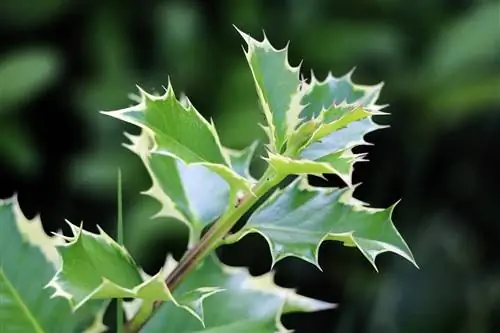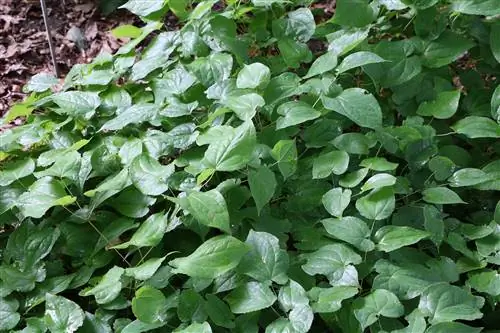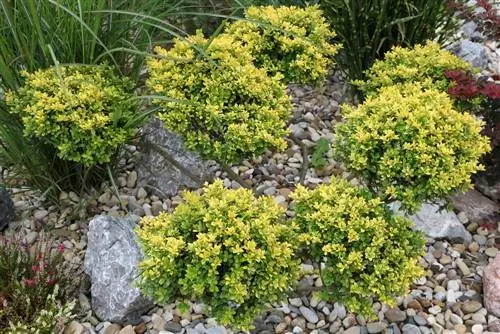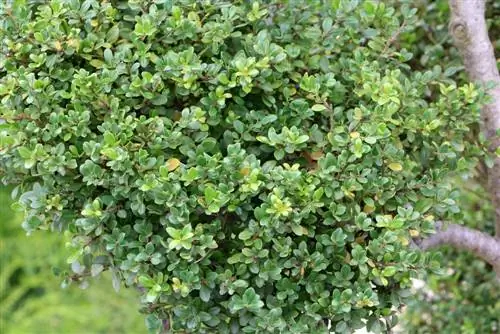- Author admin [email protected].
- Public 2023-12-17 03:39.
- Last modified 2025-01-24 12:45.
The Ilex aquifolium, also known as the European holly, is the only plant from the holly genus native to our latitudes. Due to its ease of care and its bright red berries, the holly enjoys great popularity in landscape gardening.
Location and soil
Like almost all hollies, the native European holly also has a preference for shady or semi-shady places. However, the relatively undemanding tree is also happy with a sunny location as long as the humidity is high and the soil is correspondingly moist. This also applies vice versa. The drier the location, the shady it can be. As real forest trees, the site conditions should be appropriate. An optimal soil has a slightly acidic environment and consists largely of nutrient-rich humus. Fresh and permeable soil is a basic condition for good growth. However, you won't get dense clay soils with a high lime content.
Plants
Like the deciduous Ilex Verticillata, spring is suitable for planting or sowing. In any case, it is important to wait until the frosts subside. This gives the hedge enough time to grow into the ground over a season and form a basis against the harsh winter. Soils that are particularly rich in clay should be emaciated before planting by spreading leaf humus and sand over large areas. A dense or cohesive soil is not welcome. When planting as a hedge, it is important to pay attention to the required distance between the plants. Depending on the specimen, there are between two and six plants per meter. This is how you can plant an Ilex plant successfully:
- Planting takes place in spring after the last frost
- Water the root ball extensively in the bucket
- Dig out the plant hole (almost one and a half times as wide as the root ball)
- Mix in long-term fertilizer or excavated compost
- Mix to calcareous or clayey soil with a third of plant soil and a third of sand
- Tear compacted roots with a spade to stimulate root formation
- Inserting the plant up to the root collar
- Filling the plant hole
- Come to Earth
- Water thoroughly
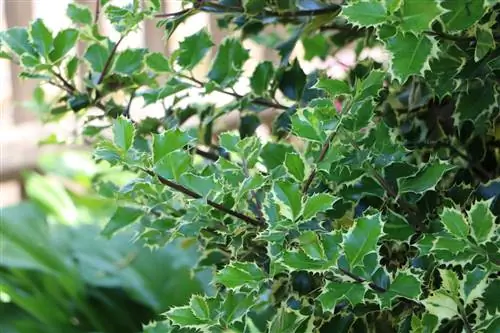
Usage
The plant is ideal as a hedge or topiary. Particularly robust varieties from the Ilex family also thrive in exposed places. Even in frosty temperatures and blazing winter sun, leaf damage or frost drying are kept at bay. The plants are ideal in Asian-style gardens in combination with other evergreen plants. More compact varieties are also suitable as solitary trees in a container culture. The native variety, Ilex aquifolium, in particular serves as a valuable breeding tree for birds. Over the summer months it supplies bees and bumblebees with nectar and at the same time acts as an insect hotel, while birds benefit from its berries as a food source over the winter months.
Attention:
The berries are poisonous to humans. The fruits contain polyphenols and ursolic acid, which can cause intestinal problems and vomiting if consumed. But it's not just the berries, the green plants are poisonous too. The parts of the plant are also toxic to pets if consumed.
Important species
In addition to the native Ilex aquifolium, the mountain Ilex, the Ilex verticillata, is of great horticultural importance. The Ilex crenata, which comes from Japan, reaches a height of up to 150 centimeters and is therefore one of the more compact plants of the plant species. Wild species reach a height of up to three meters. Its thornless leaves are oval shaped. Its properties include good cutting tolerance and malleability. Its fruits and flowers are not very distinctive.
Ilex verticillata, which comes from North America, is also known as the red winterberry and is only found in a few gardens. The deciduous shrub reaches a height of around three meters and produces bright red berries that last well into winter. It impresses with its beautiful autumn color in the colors yellow to orange.
In addition to the common species cultivated in our latitudes, there are numerous other hollies. The genus Ilex roughly includes around 600 different species, which are divided into three subgenera. There are, for example, the Ilex cyrtura, the Ilex denticulata, the Ilex fargesii or the Ilex ficoidea.
Propagation
Larger specimens can easily be propagated using lowering plants, as larger shoots in the crown area are often at ground level. In tree nurseries, Ilex plants are only propagated through cuttings. Rooting these is a lengthy and complex process as a certain amount of soil warmth is required. Propagation through cuttings is usually only possible with the help of special cultivation stations. Propagation by sowing also proves to be quite complex, as the seeds germinate only with difficulty and stratification is initially necessary.
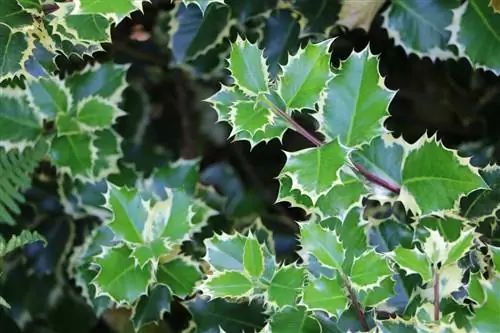
The following types of propagation are possible:
- Propagation by lowering (recommended)
- Propagation by cuttings (not recommended)
- Propagation by sowing (not recommended)
The elimination of germination inhibition, also known as stratification, is a special process in which the germination ability of various seeds is intended to be potentiated. Such germination inhibition often occurs in perennials or woody plants in temperate latitudes. The reason is obvious: if the seeds germinate in the fall, the winter frost would kill the young seedlings. In order for the seeds to germinate, they must be exposed to very low temperatures over a longer period of time.
Pouring
When planting, the palm tree should be watered thoroughly. If the plant is rooted in the soil, the plant draws moisture directly from the soil. Normally additional watering is not necessary. Pot cultures, on the other hand, require regular watering. In extreme drought, watering outdoor crops may also be necessary. Waterlogging must be avoided, as permanently wet roots can lead to the death of the plant due to the onset of root rot. Low-lime irrigation water is preferred.
Fertilize
All types of holly prefer more acidic soil, which is why calcareous fertilizer is not recommended. A high nitrogen content in the fertilizer ensures splendid growth. It is enough to fertilize the palm tree once a year. The best time to fertilize is before the growing season in spring. Fertilization is carried out with a long-term fertilizer, such as horse manure, horn shavings or universal fertilizer.
Cutting
No regular pruning is necessary. Basically, all types of Ilex plants are very robust; pruning in summer or spring usually does not cause any problems. Pruning is necessary, for example for shaping or thinning. When cutting, avoid cutting back too radically as growth is very slow. The following things should be taken into account when cutting:
- Pruning in spring or summer
- Topiary or thinning
- No radical pruning because of slow growth
- Generally compatible with cutting
The Ilex aquifolium can be cultivated not only in the form of a shrub, but also as a standard tree. As a standard tree, it has a broad oval or pyramid-shaped crown. As a standard tree it reaches a height of up to 10 meters.
Tip:
When working with holly, it is recommended to wear gloves to protect yourself from injury due to the spiny leaves.
Wintering
Overwintering holly is also easy for hobby gardeners. The vast majority of species are naturally hardy and do not require any special protection in winter. Only seedlings, seedlings or young plants are not yet hardened to withstand the frosts in winter. Winter protection is suitable here, such as fleece or fir branches for insulation and protection from icy winds. Container cultures should overwinter in a frost-free and bright place. This could be a bright hallway or an unheated winter garden.
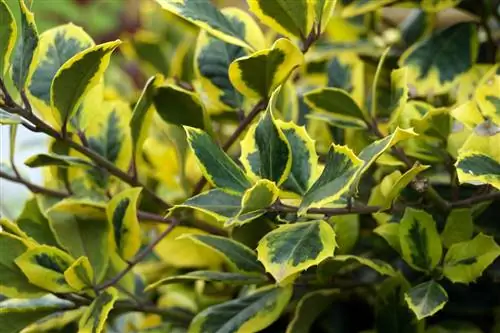
Diseases and pests
A frequent but unwelcome guest is the Ilex leaf miner. The leaf miner fly, known by its technical name Phytomyza ilicis, usually leaves behind a characteristic pattern of damage on infected plants. Their larvae attack the leaf tissue and leave unsightly burrows in the holly's foliage. The pupation of insects also takes place here. Infected plant parts must be removed and disposed of early in spring before new generations can hatch. Last but not least, black weevils or Otiorhynchus like to get lost in home gardens, where they feast on the fleshy leaves of holly. The characteristic bay damage indicates an infestation. It can be easily controlled by using nematodes.

